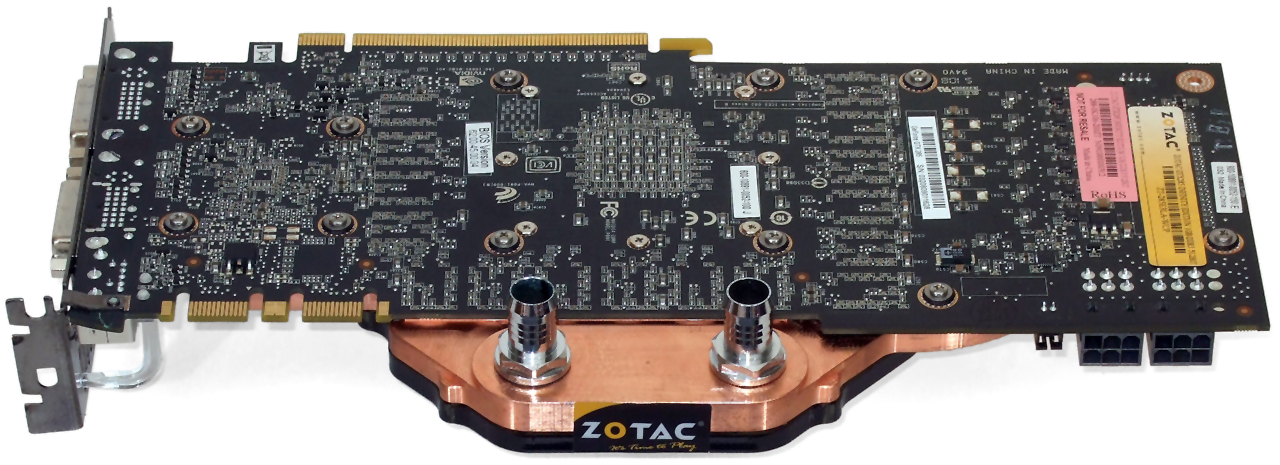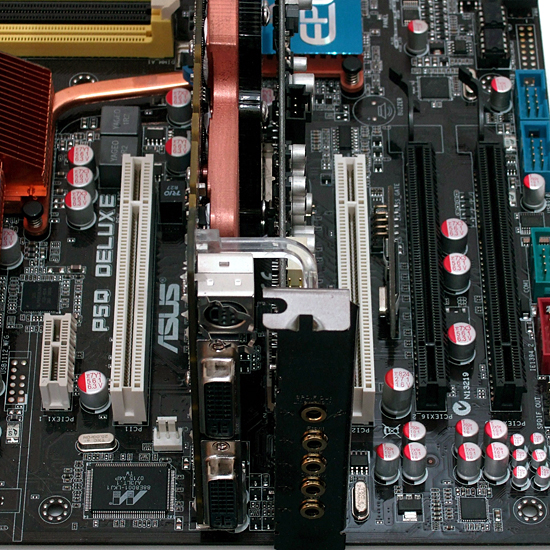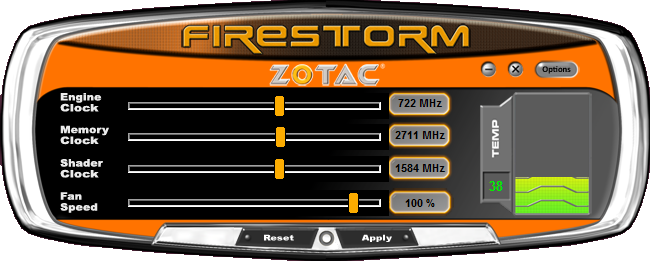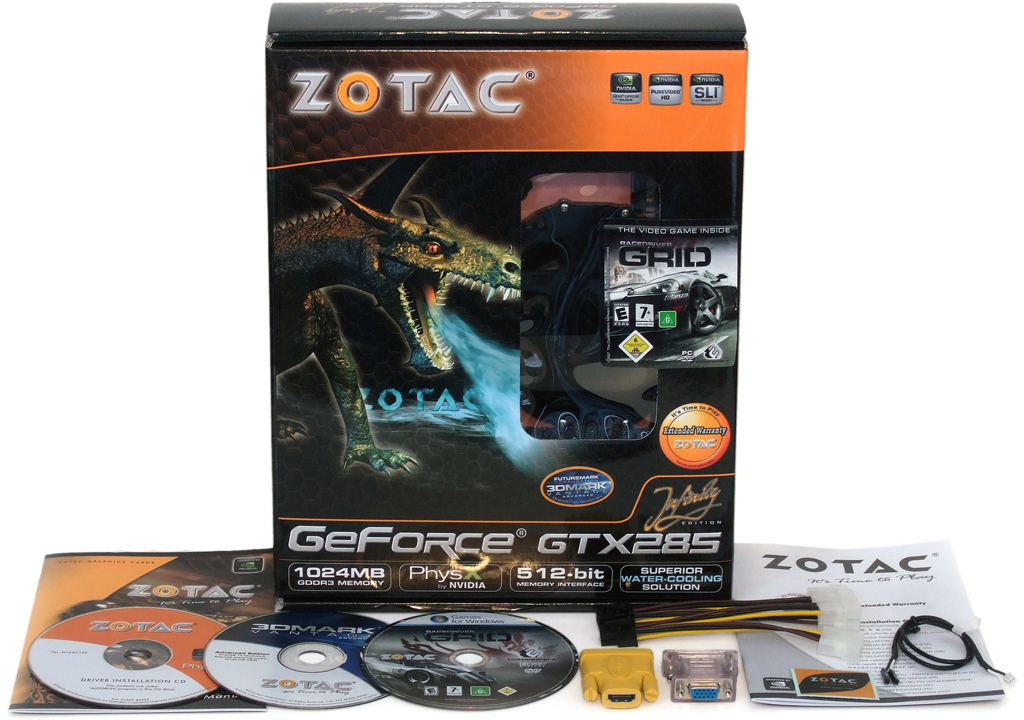GeForce GTX 285 On Water Cooling: Zotac's Infinity Edition
More Details
The Zotac GeForce GTX 285 Infinity Edition sample we received was assembled without gloves. It probably looked great when it left the manufacturer, but by the time it got to us those fingerprints had turned into dark stains upon an otherwise brilliant sand-cast copper finish. Zotac confirmed for us that each one of these cards is hand-assembled. The difference between our sample and a retail product would be a sticker covering the copper section, cleaning it up.
The GeForce GTX 285 Infinity does, in fact, use an off-the-shelf Danger Den DD-GTX285 cooler. That’s actually a good thing, because it means buyers can get fittings and associated components through the Danger Den Web site.
The DD-GTX285 water block allows cards to be chained together by swapping the plug from the card’s face with the hose barb at its top. Using multiple cards in this fashion requires each card to be spread apart by at least two slots, but the cooler’s single-slot body allows other products, such as sound and RAID cards, to be mounted in the empty slot between two graphics cards. Unfortunately, Zotac neglected to replace the two-slot back plate from the card’s original air cooler with a single-slot plate found on at least one competitor’s product. Removing the back plate offered photographic proof of this concept.
Zotac still maintains an edge over its single-slot-corrected competitor in the area of performance, because the GTX 285 Infinity is factory overclocked by a far greater amount. Builders of 3-way SLI systems will still have to reconsider all the blocked slots that Zotac’s card does not offer before deciding which solution best fits their needs.
Zotac includes its Firestorm application for overclocking the GeForce GTX 285 Infinity Edition beyond the already-high speeds it provides. The card arrived factory overclocked, with a 722 MHz GPU engine, 1,584 MHz Shader clocks, and DDR3-2700. That compares very favorably to the GTX 285’s reference 648 MHz GPU, 1,476 MHz shader clocks, and DDR3-2484, but the card was pretty much at its limit when we received it. We were able to raise the memory data rate by an insignificant 11 MHz, but tweaking the GPU and shader engine speeds resulted in instability.
Zotac adds a 3DMark Vantage Advanced Edition license and the game Race Driver: GRID from Codemasters to its accessory kit. A VGA and two six-pin power adapters allow configuration on older systems, while an internal S/PDIF-to-graphics-card cable allows onboard audio to pass through the DVI-to-HDMI adapter.
Get Tom's Hardware's best news and in-depth reviews, straight to your inbox.
-
acasel It would be better if we could see how well the zotac overclocked card overclocked.. In other words pushed to the limits.Reply -
54 deg C above ambient for W/C 285GTX makes no sense.Reply
The temperature of my 8800GTS 512 running GPU at 800Mhz (from 650MHz) + W/C southbridge and 2 X 120 Radiator. My rig maxes out at 27 Deg C above ambient. -
Crashman gothminst3r54 deg C above ambient for W/C 285GTX makes no sense. The temperature of my 8800GTS 512 running GPU at 800Mhz (from 650MHz) + W/C southbridge and 2 X 120 Radiator. My rig maxes out at 27 Deg C above ambient.Reply
Perhaps the chosen liquid cooling system doesn't have enough pressure. -
MikePHD Wow! Was this supposed to fool us into thinking they knew anything about watercooling... this arcticle is a joke. Why does the water cooled card not get overclocked, while on the same token, the "air" card gets overclocked the hell out of.Reply
This is obviously not the limit of water cooling, it's either the product of a very lame product, or the testers ignorance of water setups. -
neiroatopelcc I wonder why you bothered doing this article? As we can all agree this card only makes sense if you plan on putting it in a very tight place, or have 2-3 of them in a chassis. So why didn't you request 3 cards and compare it to a standard 3 card setup? The interesting thing would be to see if it actually helps enough to make a 3sli setup doable longterm. As it is, all the article shows is that the watercooling used is inadequate for the task it was given.Reply -
rubix_1011 It's really sad that you chose to use the Big Water kit to push the cooling on the GPU instead of incorporating the CPU loop with the GPU using the far superior 655 pump and just adding an additional radiator instead. Your temps of 56+ C are way to high for a watercooled component...you shouldn't see more than 40C at load, especially with that waterblock. You are crippling the temps and the basis of your entire article by using sub-par components in your tests. Anyone who watercools knows that today's GPUs need at minimum a 220 or similar surface area radiator to expend the heat being produced...same goes for your i7 CPU...but it looks like you have at least a 320 on it. You should have run a series loop and just added an additional 120 or 220 radiator/fans and been done with it. You'd have had much happier temp results.Reply -
grevaeg Would make alot more sense to put in a decent watercooling setup... this test doesnt give anyone ANY idea how a watercooling kit can perform...Reply
Currently running two q9550 and a 4870+ a 4870x2 on my loop.. never gets anything near ur single rad setup on a single card and cpu. Have never seen the temp going past 30c at home. -
Kaldor Good card and cooler. Bad article.Reply
You guys need to invest in a decent radiator and pump if you want to test liquid cooled components. A D5 and a MCR 220 isnt that expensive.
At least Zotac used a good cooler. Much better than the garbage EVGA uses on their cards. Al+Cu=lose. -
marraco A bit off topic:Reply
The first picture shows a case fan stating to get dusty.
The fan flaps already are white-brown.
On my city, fans become very dusty really fast. They end occluding radiators, and air vents. I even cutted out all the metal grid on the case, to reduce dust retention. but still it is catched on the metal borders.
I wish there where something to do about it. maybe some liquid or painting, or some trick to repel dust, or make it less adhesive.
(my father have a German shepper dog, and the last time I opened his case, it was completely full of dog hair.... fun)
If somebody read this, and know a fixing (not involving dogs), please, post.





